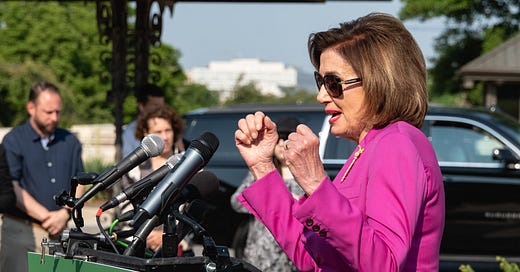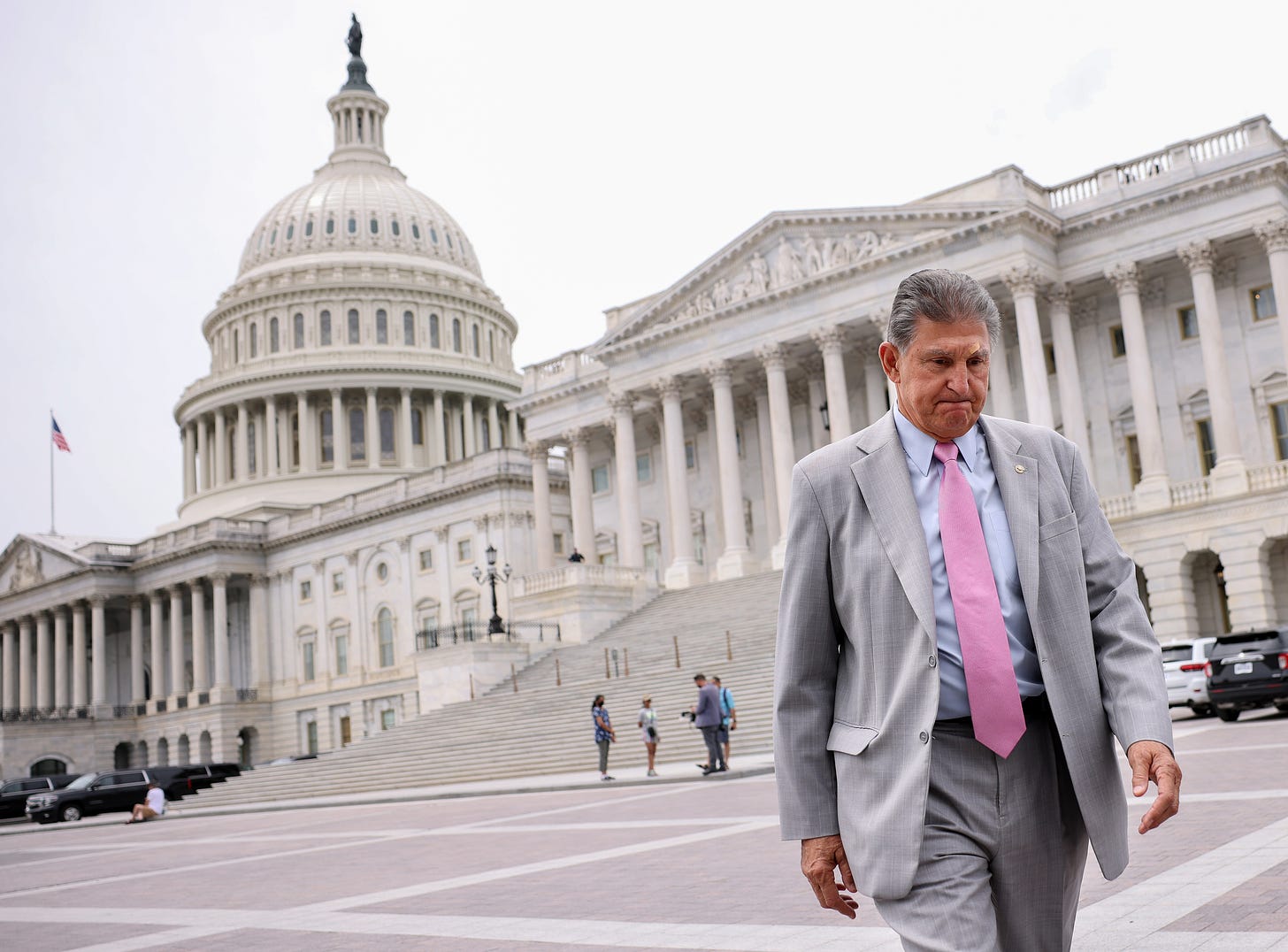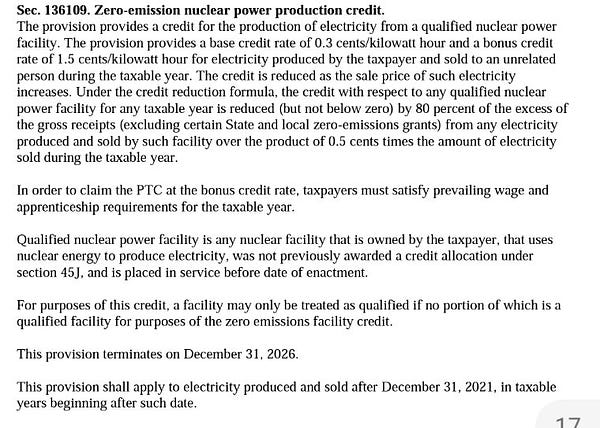After months of anticipation, Democrats have begun to reveal pieces of their upcoming Build Back Better Act (aka the budget reconciliation bill), including the key clean energy provisions.
On Monday, the House Energy and Commerce Committee began markup of its full set of recommendations for the bill. Meanwhile, the House Ways and Means Committee released its draft tax package for the bill, including the clean energy tax credits.
As negotiations around the reconciliation bill move forward, I’ll have more to say about the politics, economics, and larger implications of all this Democratic energy policy. For now, I just want to get the specifics on the record.
For one thing, there’s a lot of policy here, and it will take some time to think it through. For another, it will be important to track what gets added and (more likely) cut when the bill goes to the Senate, so this post can serve as our baseline for comparison.
Let’s start with Energy and Commerce and its Clean Electricity Performance Program (CEPP), arguably the most important single piece of energy policy on offer.
E&C: the CEPP and some other good spending
(For a quick introduction to the CEPP, see highlights from my interview with Sen. Tina Smith.)
The $150 billion CEPP would offer grants to utilities that increase their year-on-year share of clean energy by at least 4 percentage points; it would charge fines to utilities that fall short of that goal. (“Utilities” here includes any and all end-use electricity providers: vertically integrated utilities, investor-owned utilities, co-ops and munis, etc.)
For the purposes of the bill, “clean energy” is energy that emits no more than 0.1 tons of CO2-equivalent per megawatt-hour of electricity generated. This 0.1t/MWh threshold is notably stringent — it would exclude all fossil fuels and biomass unless they are equipped with carbon capture and storage.
The grants are based on a somewhat complicated formula: $150/MWh x (YoY percentage point increase in clean share - 1.5 percentage point) x total retail sales.
Say a utility boosted its year-on-year clean share by 5 percentage points. Five percentage points minus 1.5 percentage points is 3.5 percentage points. So the utility would get a one-time grant of $150/MWh for 3.5 percent of it retail sales that year.
The formula for the fines is: $40/MWh x (4 percentage points - YoY percentage point increase in clean share) x total retail sales.
Say a utility grew its share 3 percentage points. Four percentage points minus 3 percentage points is 1 percentage point, so it would pay a one-time fine of $40/MWh for 1 percent of its retail sales. (The exception here is utilities with a clean share at 85 percent or above; they are exempt from fines, but still eligible for grants.)
A utility is not allowed to fall steadily behind; any shortfall is added to the following year’s target. If it only hits 3 percentage points growth one year, the next year a utility must hit 5 percentage points growth.
Utilities can choose to tally up their performance over a two- or three-year period, to smooth over year-to-year spikes or valleys; for instance, if a utility hits 3 percentage points in year one and 3 percentage points in year two but 6 percentage points in year three, it averages out to 4 percentage points a year and it receives the grants.
This is all a bit convoluted; it would definitely keep accountants and lawyers busy. There are five things worth noting about the CEPP at this point.
First, $150/MWh is real money. Spread out over a 10-year power purchase agreement (PPA), it’s about $15/MWh/year, not that different from (but additive to) the clean-energy tax credits. That, coupled with the tight definition of clean energy, makes this a relatively strong offering, design-wise.
Second, a lot of details would be left up to the Department of Energy, which would administer the program, such as how distributed and behind-the-meter resources will be counted, how much compliance can be done through renewable energy credits (RECs), and so forth. There are lots of devils in those details.
Third, it is not accurate to say that the CEPP targets, much less guarantees, 80 percent emission reductions in the electricity sector by 2030. That is Biden’s goal, and the aspiration for the full suite of policies Dems are trying to pass, but the CEPP, by design, does not guarantee any particular outcome. How would utilities respond to this level of incentives and fines? We hope to find out! It’s a new program; it’s never been tried before. (It would kick off in 2023.)
Fourth, a study by the independent firm Analysis Group found that, through 2031, the CEPP would expand the US workforce by 7.7 million new jobs, add $907 billion to the national economy, raise $154 billion in tax revenue, and lead to over 600 gigawatts of new clean energy. It’s not a cost, it’s an investment.
Fifth, there’s no guarantee Sen. Joe Manchin (D-WV) will let this pass unmolested, or let it pass at all. He chairs the Senate Energy and Natural Resources Committee, which will be marking up the energy parts of the bill. He could kill the CEPP. He could weaken the carbon-intensity requirements to allow for dirtier energy; he could lower the required rate of clean energy growth; he could reduce the incentives or the fines. Nobody knows what Manchin will do, or why, so we’ll just have to wait and see.
Also! Other items worth noting in the E&C package.
There is $9 billion for home energy retrofits — $2,000 rebates for projects that save 20 percent relative to average energy use, or $4,000 for 35 percent. (Both numbers are doubled for low-income projects.)
There’s another $9 billion for home electrification — $3,000 per heat pump with greater than 27,500 BTU-per-hour capacity and $4,000 if it's cold-climate rated; $6,000/$7,000 for low-income projects. For heat pumps under 27,500 BTU/hour, it’s $1,500/$2,000; $3,000/$3,500 for low-income projects. In that same section are rebates of $1,250 per heat-pump water heater, $3,000 per smart electric panel, and other, smaller grants for electric stoves and dryers.
$13.5 billion for electric vehicle infrastructure, focused on underserved areas.
$5 billion to replace heavy-duty vehicles like fire trucks and school buses with zero-emission vehicles.
$9 billion for electricity transmission, including funds for DOE’s transmission planning and modeling capabilities and for state transmission planning processes.
$17.5 billion for decarbonizing federal buildings and fleets (including, one hopes, the Postal Service fleet).
$27.5 billion for a green bank, which we’re not supposed to call a green bank, but rather “nonprofit, state, and local climate finance institutions that support the rapid deployment of low- and zero-emission technologies.” (40 percent goes to vulnerable communities.)
$2.5 billion for low-income solar.
$5 billion for community-led environmental and climate justice programs.
An unspecified methane fee on leaked methane (which the industry is furiously lobbying against).
All these numbers are, based on the need, too small — especially the retrofit and electrification numbers. The heat pump money, for instance, is likely to be used up after a year or two.


Nonetheless, with a limited pot of money, E&C Dems have managed to cover quite a few bases.
Let’s move on to the Ways and Means tax package.
W&M: a bonanza of clean-energy tax credits
The tax package, which itself only covers a limited subset of policy areas, is a monster; even the section-by-section summary is 41 pages long. The green energy part (subtitle G) starts on page 9. It is basically a long list of technologies and practices that will receive tax credits.
Before getting to individual items, it’s worth noting three intriguing provisions that apply to all the credits.
First, there are now strong prevailing wage standards built in. To receive the full value of the credit, a project must show that it is paying prevailing wages and using qualified apprentices; without doing so, it can receive only a fifth of the credit value (called the “base rate”).
Second, projects that use domestic content — defined as 55 percent of total project cost from made-in-USA components and services — can get another 10 percent on top of the value of the credit.
These are important policies for the domestic workforce, drawn from successful states (like Washington), and will increase the amount of credit value that goes to good US jobs and supply chains.
Third, the energy tax credits are now “direct pay,” which means projects can get the full value without having to offset it against taxes owed. This opens up the credits to many more projects and eliminates a lot of wasteful lawyerly games around tax equity financing. (Note: the percentage available for direct pay declines over time for projects not using domestic content.)
On to some of the individual credits:
The production tax credit (PTC) would be extended through the decade. It would go to qualifying clean electricity sources — wind, solar, geothermal, landfill gas, methane gas with CCS — based on MWhs produced: $25/MWh ($5/MWh base rate).
The investment tax credit (ITC) would also be extended; it would be available to solar and geothermal, and now, as of this bill, energy storage, biogas, microgrid controllers, and, uh, “dynamic glass.” It would cover 30 percent (6 percent base rate) of the cost of a project. (A solar project could choose the PTC or ITC, but couldn’t get both.)
A bonus ITC would be available to projects that locate in a low-income area (additional 10 percent) or are themselves low-income benefit or housing projects (additional 20 percent). This is an excellent way of building environmental justice into the tax system.
Note: both the PTC and ITC would be restored to their full original value, higher than any current credit, and extended through the decade. This is a very big deal.
The electric vehicle (EV) tax credit has been revived and expanded. It would now be fully refundable and no longer limited by manufacturer. It starts at $4,000 per vehicle; for vehicles that go into service before 2027, there’s an additional $3,500 (that’s $7,500); for vehicles built at a US assembly plant with a union-negotiated collective bargaining agreement, there’s an additional $4,500 (that’s $12,000); for vehicles assembled at plants that use at least 50 percent domestic content, there’s an additional $500. So, for a domestically manufactured, domestically sourced EV purchased next year, the total available credit is $12,500 (limited to half the vehicle purchase price). That’s huge!
Note: The EV tax credit would be available only for vehicles under specific price limits: $55,000 for sedans, $64,000 for vans, $69,000 for SUVs, and $74,000 for pickup trucks. Also, the amount of available credit phases out quickly for joint households above $800,000 income, or single households above $600,000. In short, the credit is meant to be available primarily to middle-class voters buying mid-range EVs.
Note 2: Automakers that use non-unionized workforces, like Toyota, Honda, and Tesla, are furious about the union provisions. The awkward truth is that some of the best automakers on EVs have been non-union, while union shops like Ford and GM have been among the worst. It’s a bit of a dilemma for progressives.
There is also a credit for commercial EVs, worth up to 30 percent of vehicle cost.
Happily, there’s a credit for used EVs, ranging from $1,250 to $2,500, depending on battery capacity; the credit would be capped at 30 percent of the sale price, for vehicles costing no more than $25,000 and at least two years old.

Even more happily, there’s a new electric bicycle credit, worth 15 percent of the purchase price. The max available credit is $1,500 (joint filers can use it toward two bikes). The credit starts phasing out at incomes above $75,000; the maximum total price of a qualifying bike is $8,000.
Note: Folks are grousing on Twitter about how much more generous the EV credit is than the bicycle credit, and how the bicycle credit should be bigger, and how absurd it is to means-test a friggin’ bicycle credit, and they’re right about all of it. Still, it’s nice e-bikes at least got a nod.
The 45Q tax credit for carbon capture, utilization, and storage has been extended through the decade: $50 per ton for sequestered carbon dioxide; $35 per ton for use of CO2 in products or enhanced oil recovery.
Added to 45Q is a new $180-per-ton credit for direct air capture of CO2.
Hooray, a new investment tax credit for transmission lines! Lines of at least 275 kilovolts, capable of carrying at least 500 megawatts, placed in service before 2032, receive a credit worth 30 percent of project costs. (Read my transmission series to understand why this is a good thing.)
Also worth cheering, though more controversial: a production tax credit for existing nuclear power plants, calculated via a formula I do not pretend to understand.
A new sustainable aviation fuel credit would offer $1.25 per gallon for aviation fuels that cut lifetime GHG emissions (vs. jet fuel) at least 50 percent, with another penny per gallon available for each percentage point above 50.
A new clean hydrogen production tax credit would offer $3 per kilogram to hydrogen with 95 percent fewer lifecycle GHG emissions than hydrogen made through the currently dominant method, steam reforming. That could include hydrogen made through electrolysis driven by renewable energy or through biomass gasification with CCS. Credits of $0.60 to $1.02 would be available to hydrogen with between 40 and 95 percent fewer GHGs, which could include “blue hydrogen” made by steam reforming with CCS.
There are credits for energy-efficient homes, up to $2,500, with a bonus tier of $5,000 for certified zero-energy homes.
The clean manufacturing tax credit (48C) has been extended. It would offer up to 30 percent of the value of investments in clean manufacturing facilities, i.e., facilities manufacturing solar panels, wind turbines, EVs, batteries, etc. $400 million a year of the credit money would be reserved for projects in “automotive communities.”
A credit for environmental justice programs would distribute $1 billion a year, on a competitive basis, to institutions of higher learning that gather data to help improve environmental justice outcomes.
Notably missing from this list is any reduction in fossil fuel subsidies. This is frustrating, since less than 24 hours before the package was released, Senate Majority Leader Chuck Schumer was saying, “we need to take away all the subsidies for oil, gas, and coal. We will have that in our bill.” (It’s at minute 26 of this video.) Where did the subsidy cuts go? Who took them out?
Anyway, all told, the Joint Committee on Taxation estimates that the Ways and Means tax package would cost $1.2 trillion over 10 years; the “green energy” subtitle would account for $235 billion. Of course, that’s just an estimate — it could be lower or higher in practice, depending on the uptake of the credits and the growth they spur.
Now let’s see how much survives the Senate
Like I said, there will be more to talk about as the bill is negotiated. For now, I’ll leave you with three observations.
First, is this enough? Ha ha, no. No climate policy is ever enough. This is far short of the $10 trillion that would be needed for a true Green New Deal. It’s far short of the $6 trillion bill Sen. Bernie Sanders first proposed, back in June. It is, from a climate perspective, a ludicrously low level of investment and mobilization.
Nonetheless, this is what the lamentably small group of climate-focused legislators were able to squeeze from a chaotic process. This is a reflection of the relative weight climate carries in the House.
Second, this is the high-water mark, so enjoy it while it lasts. Sens. Manchin and Kyrsten Sinema (D-AZ) are going to try to hack down the overall level of spending, and Manchin has already signaled his intention to go after some of the energy provisions, including the CEPP. I have no idea what will happen in the Senate — my brain is tired from trying to predict — but given that Manchin is involved, it’s likely to be unpleasant.
Third, I know this isn’t helpful right now, but damn is it stupid for a wealthy democracy to make policy the way we do. Because every policy of any size has to be crammed through the budget reconciliation process, it all ends up in the tax code, a complicated skein of credits and loopholes that encourages rent-seeking and keep armies of lawyers employed.
This is not how any energy wonk, including the energy wonks on Democratic congressional staffs, would write policy if offered a blank sheet of paper. It is kludge upon kludge, a Rube Goldberg mechanism reverse-engineered to conform to anachronistic budget rules administered by a parliamentarian-cum-shaman.
But it is what’s possible now. American democracy is staggering, barely upright, and people of good will are scrambling to do the best they can under the circumstances. There’s no time left for infighting. Let’s just get this thing over the finish line.


















Share this post